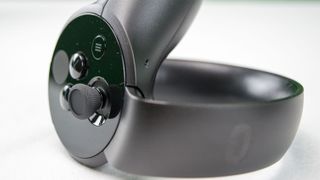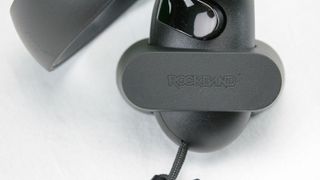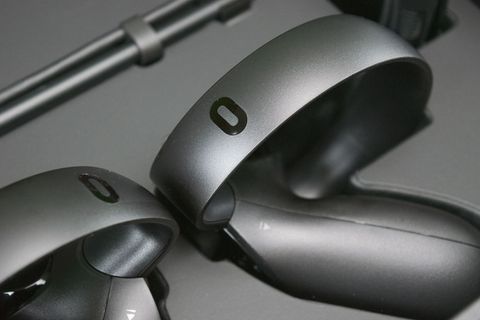Early Verdict
There’s nothing quite like hand presence in VR, and Oculus Touch delivers. If you own an Oculus Rift, Touch is almost a necessity to complete your VR gaming setup.
Pros
- +
Lightweight
- +
Many input options
- +
Haptic feedback
- +
Hand gestures
- +
Lots of compatible content
Cons
- -
No rechargeable batteries
- -
Not as comfortable as expected
- -
Possibly overwhelming for non-gamers
Why you can trust Tom's Hardware
Introduction And Overview
Oculus released the Rift VR HMD in March 2016 to mixed fanfare. On the one hand, Oculus lived up to its promise to bring virtual reality from the research lab to the consumer market. On the other hand, the product that Oculus delivered felt decidedly incomplete, thanks entirely to the HTC Vive, which launched the following week, complete with room-scale tracking and tracked motion controllers.
It took Oculus the better part of a year to follow up with its Touch motion controls, but the company finally has a complete package that delivers immersive VR with hand presence.
The Touch controllers open many doors to different kinds of VR content on the Rift platform. Oculus’ team designed a remarkable piece of technology, and it couldn't come soon enough. Though the Rift HMD was clearly a product of significant attention to detail, we believe that Valve and HTC one-upped it with their Vive system.
Had the Rift launched sooner, months ahead of the Vive, reviewers wouldn't have spent so much time lamenting the lack of room-scale VR. Presumably, Oculus expected traditional gamers to be its early adopters, and they'd undoubtedly appreciate the familiarity of a gamepad. The company focused on fit and finish for its roll-out. Hand controllers weren't part of the phase-one plan. Until they had to be, that is.
HTC stole the show at Mobile World Congress 2015. It announced a partnership with Valve to introduce the world's first room-scale VR platform. Following that, all eyes were on Oculus for a response.
Evidently, Oculus was already working on a hand-tracking solution to complement the Rift, and it revealed Touch in June 2015. But Oculus didn’t stop with tracked controllers. The company believes Touch takes presence to the next level by adding avatar hands, which allow you to make social gestures in virtual reality. Are these really necessary, though? Does Oculus’ answer to the Vive wands live up to our expectations? Let's find out.
MORE: The Oculus Rift Review
MORE: The HTC Vive Review
Meet The Touch Controllers
Oculus spent a lot of time refining the design of its Touch controllers. By the time it revealed Touch, the company had already worked out the size and shape it'd use. But as engineers tend to do, Oculus continued iterating until they were happy with the final product. A great many prototypes were sent out to developers, and their feedback went into determining an ultimate combination of hardware features, functionality, and comfort.

As you no doubt already know, the Touch controllers are tracked wands that complement Oculus' Rift headset, utilizing the Constellation tracking system to provide six-degrees-of-freedom (6DoF) movement for your hands in VR.
You get one controller for your right hand and another for your left. Touch is not ambidextrous. Each device is form-fitted for a specific hand, and both controllers have slightly different configurations.
Touch controllers include the same inputs found on Microsoft's Xbox One controller except for the D-pad and Xbox Home button. Each Touch controller features six buttons and a thumbstick. The face of the left controller includes the X and Y button, the Xbox menu button, and the thumbstick, which doubles as the sixth button input. On the handle, you’ll find a trigger button for your index finger and a grip button for your middle finger.
The right-hand Touch controller is a mirror of the left controller, except it has different face buttons. You get the A and B buttons, and the Oculus Home button.
The triggers on the Touch controllers are analog; the harder you pull, the stronger the input. The trigger under your index finger has a firm spring inside that provides tactile feedback. For comparison, if feels a lot like the trigger on Microsoft’s Xbox One controller.

The grip button under your middle finger doesn’t offer the same tactile response. Sure, it pops back out when you let it go, but the spring inside doesn’t provide much resistance when you press down. This button is deceivingly light, and it almost feels hollow.
Oculus' thumbsticks and the circumference of their rotation are smaller than what you're used to from the Xbox One, DualShock 4, and Wii U controllers. They also offer more resistance than most gamepads, which we think benefits precision. The smaller rotation area fits the natural motion of your thumb better than the larger sticks on console controllers, too.
Ergonomically, the Touch controllers fit your natural hand position well. Their handles rest in your palms as your fingers wrap around. With that grip, your thumb is free to work its magic comfortably up top.

The Touch controllers are balanced well. Most of their weight comes from the battery, so the palm of your hand wraps around the heaviest part. In fact, Oculus designed the controllers to be held comfortably with just your ring finger and pinky. You don’t even need your thumb pressing on the controller's face.
Oculus put all that effort into balancing the Touch controllers for a reason: It added capacitive touch sensors to them, enabling natural hand gestures in virtual reality. The controller can tell when your thumb, index, and middle finger are on it. Oculus then mapped this information to your avatar's digital hands. As a result, you can point, give a thumbs-up, make the finger-gun gesture, open your hand to wave, and even make a fist.
In addition to gesture-tracking sensors, the Touch controllers include rumble motors in the handles that vibrate to help you “feel” the virtual world you’re touching.
MORE: The History of Virtual Reality
MORE: AMD Liquid VR Explained
MORE: Nvidia GameWorks VR Explained
No Internal Batteries
Each Touch controller gets its power from a single AA battery that fits into the handle under a magnetically-sealed cover. Naturally, powering the controllers with replaceable batteries has advantages and disadvantages.
A built-in, rechargeable power source frees you from maintaining an inventory of batteries at home, but you also have to remember to plug in between uses. If you kill the batteries in a Vive controller, you're forced to wait as they charge back up. With the Touch controllers, you can simply replace the battery and get back to gaming.




Unlike the Xbox One controller, Oculus' Touch controllers don’t have USB ports, so you can't upgrade to a rechargeable battery pack like the Xbox Play and Charge kit. At least Oculus does give you your first set of batteries.
What Else Comes In The Box?
The Touch controllers require at least two Oculus Sensors to function properly. The headset works with just one because you’re almost always facing the Oculus Sensor, and there’s nothing to occlude its view.
Touch controllers add two more tracked objects, though, which could potentially occlude the sensor's view of one or more devices. To avoid this, Oculus includes a second sensor with its Touch controllers. That sensor is identical to the one you received with your Rift, and you'll need an extra USB 3.0 port for it.

The Touch package comes with one more component. Oculus collaborated with Harmonix to build Rock Band VR for the Rift. Instead of building a Constellation-tracked guitar, the companies worked together to create the Rock Band Connector, which lets you mount a Touch controller to Harmonix’s existing peripherals.
You might wonder why Oculus would give everyone the bracket instead of Harmonix selling it with the game. But remember that all of Oculus' titles are digital downloads. The company bundles a bracket with Touch so Rock Band fans aren't forced to go out and buy a physical product after downloading the game. You still need a Rock Band guitar, but you can use old ones if you have them from previous versions.
| Touch | Sensor | ||
|---|---|---|---|
| Orientation sensors: | Gyroscope, accelerometer | Sensor mount: | Integrated stand, 1/4-20 camera mount-compatible |
| Outside-In Tracking: | Oculus Rift-compatible tracking | Tracking technology | Oculus Constellation tracking |
| Battery: | AA battery | Sensor cable: | 2.5m cable, requires USB 3.0 |
| Input per controller: | 1 index trigger, 1 grip trigger, 2 action buttons, 1 home or menu button, 1 thumbstick with click button | Play space: | 2x2 meters for front-facing two-sensor content; 1.5x1.5 meters for two-sensor 360° setup; 2.5x2.5 meters for three-sensor 360° setup |
| Dimensions: | 110mm wide, 100mm high; 98mm long | Warranty: | Limited one-year warranty, except if purchased in the EU which grants a two-year warranty. |
| Weight: | 136 grams (without battery), 156 grams (with battery) | MSRP: | $199 for Touch controllers with Oculus sensor |
MORE:
Oculus' Uncompromising Obsession With Hardware
MORE: The First 30 Oculus Rift Launch Titles
MORE: The Past, Present, And Future Of VR And AR: The Pioneers Speak
MORE: Audio, Audio, Audio: The Key To Virtual Reality Immersion Is The Audio
Kevin Carbotte is a contributing writer for Tom's Hardware who primarily covers VR and AR hardware. He has been writing for us for more than four years.
-
edhem So it appears that the Oculus setup costs more than the HTC Vive, and for someone who does not have Donald Trump hands it might be uncomfortable? In addition, it appears that the Facebook Rift is not that easy to use for non-gamers, which to me seems to be very unusual for Facebook.Reply -
scolaner After spending a couple of days with these things at OC3, I was super impressed. One thing I wish for, though--and Kevin pointed out--is control over (for lack of a better term) the DPI. I like to dial down my mouse DPI somewhat, and I want to do the same with the Touch controllers.Reply -
stairmand I didn't bother to order these for my Rift, too expensive and the whole room-scale bit of VR didn't impress me. Driving games, flight sims etc are amazing but everything else seems a bit mediocre to me.Reply -
dark_lord69 I have an Oculus but having a hard time convincing myself to buy these $200 controllers.Reply
When I first bought a controller it was about $25-30, which seemed like a lot for a controller. Then I bought one for my PS3 and I thought $50 was completely insane. So, no surprise that I'm not willing to listen to my wife bitch about spending $200 on controllers that don't even come with a game...
You'll have to do a lot to convince me that these are worth $200. -
Sakkura Reply18963471 said:So it appears that the Oculus setup costs more than the HTC Vive, and for someone who does not have Donald Trump hands it might be uncomfortable? In addition, it appears that the Facebook Rift is not that easy to use for non-gamers, which to me seems to be very unusual for Facebook.
It costs the same as the HTC Vive, actually less for people who preordered. And the Touch controllers are extremely comfortable in my average hands.
As for ease of use, the Rift certainly has the Vive beat. Setup is very intuitive.
18963675 said:I didn't bother to order these for my Rift, too expensive and the whole room-scale bit of VR didn't impress me. Driving games, flight sims etc are amazing but everything else seems a bit mediocre to me.
I think you should reconsider, unless you're dead set on sticking to those genres. It is pretty damn mind-blowing when you first pick up and use these controllers. -
Chris_342 I've seen maybe 5 reviews and none complained about the comfort and I agree. I have medium sized hands and after a long demo at Best Buy on 2 separate occasions I felt that the controllers were the best I've used for the games I played.Reply -
kcarbotte Reply18963471 said:So it appears that the Oculus setup costs more than the HTC Vive, and for someone who does not have Donald Trump hands it might be uncomfortable? In addition, it appears that the Facebook Rift is not that easy to use for non-gamers, which to me seems to be very unusual for Facebook.
I wouldn't go so far as the say its not that easy. Most of the games don't rely on the buttons that much.
The buttons and joysticks add complexity, which will deter newcomers, such as people who have never played a video game before. But i would argue that Touch controllers are no more intimidating than a gamepad to non-gamers. .
-
scolaner Reply18963837 said:18963471 said:So it appears that the Oculus setup costs more than the HTC Vive, and for someone who does not have Donald Trump hands it might be uncomfortable? In addition, it appears that the Facebook Rift is not that easy to use for non-gamers, which to me seems to be very unusual for Facebook.
It costs the same as the HTC Vive, actually less for people who preordered. And the Touch controllers are extremely comfortable in my average hands.
As for ease of use, the Rift certainly has the Vive beat. Setup is very intuitive.
18963675 said:I didn't bother to order these for my Rift, too expensive and the whole room-scale bit of VR didn't impress me. Driving games, flight sims etc are amazing but everything else seems a bit mediocre to me.
I think you should reconsider, unless you're dead set on sticking to those genres. It is pretty damn mind-blowing when you first pick up and use these controllers.
Note: Parse out room-scale from the Touch controllers...those are two different things. Both great. I might buy a Rift without the third cam. But I would definitely *not* buy one without the Touch controllers at this point...they're really, really great.
-
kjohnsen045 A solution to the hand cramping issue the author had is to use something like Sugru to mold your own grip around the baseReply
https://sugru.com/
